You Too Can Implement Your Own
Overseas Direct Aid Project
The past and rapidly outdated inter-governmental aid programs such as the
"Overseas Direct Aids (ODAs)" fall far short of penetrating into the
remote areas of the world like the Himalayan regions of Nepal. The Tangden
Monastery nestled in the Himalayan highlands of the Humla District of
Nepal is not only the religious, but also the social and cultural, center
of the people of the surrounding villages. The installation team
dispatched by the Lotus Energy headquarters in Katmandu had to traverse
deep ravines and steep ridges (picture to the left) for several hours
after being dropped to a landing pad by a helicopter loaded with heavy
burden of the solar power machines and equipment. Upon crossing the last
ridge (picture), the team members finally collapsed and were rescued by
the horses (picture) dispatched by the Tangden monastery. The monastery
and the villages provided the food and lodging for the team and helped the
entire installation process by providing the needed labor. Upon completing
the installation on November 17, the monastery held a puja, a Buddhist
ceremony in appreciation of the solar lighting system just installed.
Tangden Monastery and
Its Surrounding Natural Environment
-- What
solar energy can do to the remote areas in Nepal
[Distance from the modern
civilization - a handicap or a blessing?]
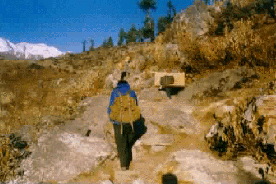 Bordering with China to the north, and India to the southwest, in Humla,
the extreme northwestern district of Nepal, stands the Tangden Monastery
(picture to the right) above the village nestled at the foot of a mountain
slope.
Bordering with China to the north, and India to the southwest, in Humla,
the extreme northwestern district of Nepal, stands the Tangden Monastery
(picture to the right) above the village nestled at the foot of a mountain
slope.
The monastery has always been the center of the religious and cultural
life of the people of the neighboring villages despite the fact that the
area remained totally isolated from the outside world by rugged natural
terrains requiring 25 days of trekking by visitors after leaving their
cars on the roadside. Modern utilities had been practically unknown, let
along an electrical lighting system.
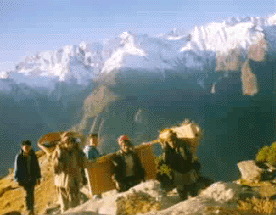 On this mission, however, the installation team took a helicopter ride to
the nearest landing pad, though still requiring 14 hours of trekking
through mountain paths backpacking the equipment and supplies, men and
horses alike (see the picture on the right-hand side).
On this mission, however, the installation team took a helicopter ride to
the nearest landing pad, though still requiring 14 hours of trekking
through mountain paths backpacking the equipment and supplies, men and
horses alike (see the picture on the right-hand side).
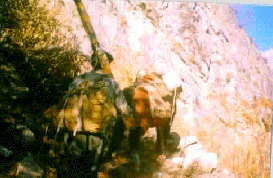 The solar lighting project provided the Tangden monastery with a
environment-friendly lighting system. For anyone living in an urban
environment of the outside world, it will be almost impossible to imagine
how people would live without modern utilities, let alone such amenities
as telephone, radio cassettes and television. Worse than mere
inconveniences, the local people have continuously suffered from poor
eyesight and respiratory complications caused by the excessive fumes and
soot as a result of the traditional wood-burning practice for lighting
purpose inside unventilated rooms. Besides, this practice added
significantly to a steady progress of forest destruction in areas where
trees are hard to grow.
The solar lighting project provided the Tangden monastery with a
environment-friendly lighting system. For anyone living in an urban
environment of the outside world, it will be almost impossible to imagine
how people would live without modern utilities, let alone such amenities
as telephone, radio cassettes and television. Worse than mere
inconveniences, the local people have continuously suffered from poor
eyesight and respiratory complications caused by the excessive fumes and
soot as a result of the traditional wood-burning practice for lighting
purpose inside unventilated rooms. Besides, this practice added
significantly to a steady progress of forest destruction in areas where
trees are hard to grow.
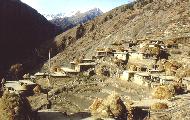 The short-term objective of this Virtual Foundation project is to provide
a safe lighting system for the monastery, which in turn is expected to
greatly enhance the environment for the religious, educational, and social
activities for the local villagers. From the long-term standpoint, it is
expected to create a living example and a show case in a remote Himalayan
district in Nepal of what solar energy can do to improve the quality of
life in many other remote areas of Asia, shedding new light on an
alternate road to modernization built upon local initiative and
technologies friendly to the natural environment.
The short-term objective of this Virtual Foundation project is to provide
a safe lighting system for the monastery, which in turn is expected to
greatly enhance the environment for the religious, educational, and social
activities for the local villagers. From the long-term standpoint, it is
expected to create a living example and a show case in a remote Himalayan
district in Nepal of what solar energy can do to improve the quality of
life in many other remote areas of Asia, shedding new light on an
alternate road to modernization built upon local initiative and
technologies friendly to the natural environment.
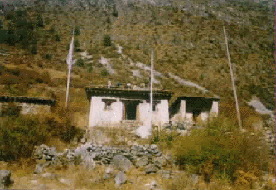 The picture to the left above is a nearby village above which the Tangden
Monastery stands. People in this area earn their livelihood through hard
labor on their terraced crop lands under severe natural conditions, and it
is their voluntary contributions that the monastery is maintained as their
religious and community service center.
The picture to the left above is a nearby village above which the Tangden
Monastery stands. People in this area earn their livelihood through hard
labor on their terraced crop lands under severe natural conditions, and it
is their voluntary contributions that the monastery is maintained as their
religious and community service center.
For the Japanese viewers, the architectural features of the Tangden
Monastery will in no way remind them of a Buddhist temple as they know it
because the Buddhist civilization reached Japan by way of China where the
original Indian features were largely Sinicized including architecture.
Such difference is commonly observed throughout the Nepal Himalayas as
witnessed in the Virtual Foundation's Herambu project completed this summer.
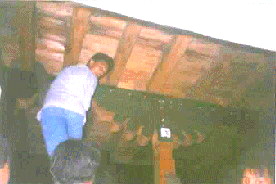 A functioning solar electric system such as this in a remote Buddhist
monastery in Nepal promises to enhance and expand its roles and functions
as noted above. Children can now learn more in an easier reading and
writing environment, while adult villages can also benefit from multiple
use of the existing facilities built around religious ceremonies and
events. This, in turn, will give rise to newly discovered needs in the
local life that must be addressed.
A functioning solar electric system such as this in a remote Buddhist
monastery in Nepal promises to enhance and expand its roles and functions
as noted above. Children can now learn more in an easier reading and
writing environment, while adult villages can also benefit from multiple
use of the existing facilities built around religious ceremonies and
events. This, in turn, will give rise to newly discovered needs in the
local life that must be addressed.
It is not a pipe dream that someday in no distant future, at the very
least for those young children now studying under brighter and safer
light, the rapidly advancing solar technology will enable these
communities to have a direct access to the Internet via satellite to
become integrated into the fast growing global information society, in
which everybody can talk to every body else face to face.
As we move into the 21st century, therefore, we hope we will be able to
help the Tangden villages, and many others like them, improve their own
lots by implementing a sustainable development plan of their own starting
from solar electrification and reaching into such important areas of life
as education and public health.
[Installation Team at Work at
the Tangden Monastery]
A Cooperative Venture with Local People
As already said, the Lotus Energy installation team was aided by the
monastery's representatives providing horses for the last leg of the
difficult transport. The team members were also provided with living
quarters, food and local labor for installation work during their stay at
the monastery. In this sense, the solar electrification project is truly
an international cooperative venture between local communities and a
motivated Nepalese enterprise with the needed fund coming from Japanese
donors.
Now then, let us see how the installation work was actually performed, and
how the dark interior of the Tangden Monastery was finally lighted up by
solar energy by the pictures taken by team members during their trip.
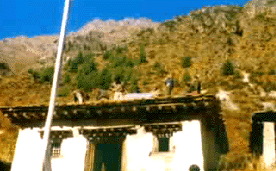 The picture to the left shows the main building of the Tangden Monastery,
and workers are already on the roof installing the solar panels according
to the specifications.
The picture to the left shows the main building of the Tangden Monastery,
and workers are already on the roof installing the solar panels according
to the specifications.
The next picture to the right shows the final stage of the panels
installation work. Everybody worked hard to beat the winter season coming
just around the corner making the best use of the blue-sky weather of the
remaining sunny days. As planned, they completed the actual field work in
just over two days on November 17, 1998, checked out the system, and
conducted maintenance and repair training sessions for local people.
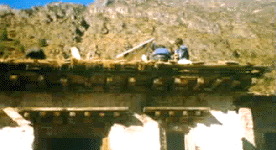
All in all, the "Operation Tangden" was completed within a week, thanks to
the generous support by local people led by the Head Lama and the monks,
who now knew that good things were finally going to happen. In fact, the
actual installation work not just proceeded smoothly, but also produced
results considerably over and above early expectations in terms of cost
vs. performance. As a result, the project's second-stage plan appears open
for fund application for purposes other than solar electrification per se,
such as addressing the newly arising need to provide for education under
brighter light and the residual problems of poor eyesight and lung
diseases.
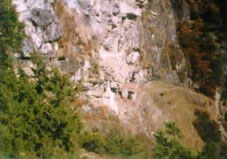 In front of the monastery and nearer to the bottom of the steep valley is
a natural cave which is used as a hidden meditation room by the monks (at
the center of the picture). Everybody helped make this project work
because of the common realization that it will not harm Tangden's pristine
nature while eliminating the health hazards the past wood-burning practice
made unavoidable. The monks and the installation workers enjoy small talks
basking in the afternoon sun near the meditation cave. It will be great if
the future Tangdens will have Internet access so that the Japanese donors
can also join them in on-line chats with those who actually do the work
and benefit from it.
In front of the monastery and nearer to the bottom of the steep valley is
a natural cave which is used as a hidden meditation room by the monks (at
the center of the picture). Everybody helped make this project work
because of the common realization that it will not harm Tangden's pristine
nature while eliminating the health hazards the past wood-burning practice
made unavoidable. The monks and the installation workers enjoy small talks
basking in the afternoon sun near the meditation cave. It will be great if
the future Tangdens will have Internet access so that the Japanese donors
can also join them in on-line chats with those who actually do the work
and benefit from it.
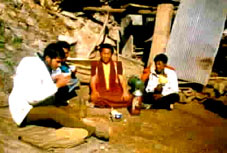
The Virtual Foundation projects will then cease to be "virtual" in every
sense of the word. Remote areas will no longer "remote," and Shangri-La
will not be a Shangri-La any more. Instead, all of us will find ourselves
living in a world of global cohabitation which tolerates diversity and
totally unrelated to the past pattern of the Western industrialization at
the cost of destruction of the Himalayan ecosystem by building large dams
and factories. It will be the starting point of a new global civilization
of the 21st century built upon the wedlock of East's wisdom and West's
technology. It must be friendly not only to the natural environment, but
also to fellow human beings. For, humankind is an integral part of the
environment, and it is only when we come to possess both wisdom and
technology with which to become friendly to fellow human beings that we
will perhaps have a real hope to preserve the natural environment of the
planet earth.
Lotus Energy Team at Work
On July 9, 1998, two teams of installers left Kathmandu Valley to
Malamchipul Bazar where they split to proceed toward both Tashi Choling
and Pema Choling Monasteries in the Helambu region of Nepal. Both
monasteries are a one-day uphill trek (for acclimatized Nepalese) from
Melamchipul Bazar which in turn is one day's drive out of the valley.
The installation took over 7 days at Tashi Choling and 5 days at Pema
Choling gompas, including the days spent on travelling. (Photos by
courtesy of Lotus
Energy Pvt. Ltd., Kathmandu, Nepal)
|
The Day Solar Power Lighted
the Monastery
The picture below shows the solar panels installed on the roof of the
Tangden monastery already transmitting power to the lighting system. We
asked the Lotus Energy head office in Katmandu to send us as many indoor
pictures as possible taken at the time of switching on the light bulbs.
Unfortunately, however, the rolls of film used happened to be so low in
ASA sensitivity that most indoor snap shots turned out to be underexposed.
We did our best to enhance their quality and uploaded only those which
responded relatively well.
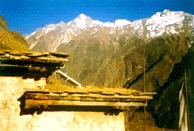
In the picture below, the leader of the Lama is handing the installation
team is receiving a while silk scarf, a traditional gift, in appreciation
of the job well done, which is destined to go a long way in improving the
quality of life at the monastery.
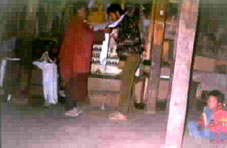
The picture below at right shows the Lama chanting sutra in front of the
golden Buddha image under the first time ever solar light as children
watch in utter curiosity. No one has ever seen such an event in Tangden
Monastery's entire history, and the impact of the occasion was so powerful
that most people present were remained in shocked silence for a while.
Only the children were excited and immediately began running around
playing hide-and-seek.
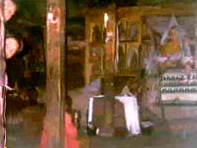
the next five pictures below depict the scenes of the inauguration
offering ceremony (puja) performed by the head Lama and monks. From left
to right, the head Lama is chanting sutra as his monk plays Nga drum, a
special ceremonial drum leading the rhythm of the chants. In the third
picture are the villagers who came to watch the ceremony progressing in
bright solar light sitting in front of religious paintings which they can
now see in such brightness and clarity.
Solar Electrification and the
Next Problems
Such traditional Buddhist way of life now brought to your living room via
Internet and the Virtual Foundation Japan is the common string running
through the entire Himalayas starting from Tibet, and running through
Nepal, Bhutan, down to the Indian side of the highlands, in virtual
isolation from the outside world still adhering to their traditional
cultural past.
At the Tangden Monastery of tomorrow, children will have a better
education and their parents easier time holding meetings and attending
ceremonies and rituals. Thus, it is hoped that they will better prepare
themselves for the inevitable changes that are coming as we move into the
new century. Let us help them make the needed preparations by providing
pertinent help to make the transition an easier experience.
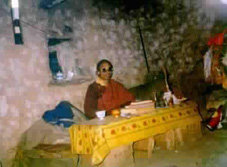
The students of the Chiba University of Commerce and Dr. Ichimura of the
Tokyo Life Science Laboratory are now talking about what changes should be
considered in the contents of the stage-two project in the spring of 1999.
Tentatively, they are considering the following two areas: (1)
Education-related support such as books and classroom supplies, and (2)
conducting a survey of the existing health problems with emphasis on the
ill effects of the past wood-burning practice in order to determine how
they can be addressed.
It must have become obvious by now to the viewers of this report that
building and maintaining a top-rate school or medical clinic is an
unrealistic proposition. The important thing is to determine just what is
really feasible and meaningful at this stage in helping the people at the
Tangden Monastery and the villages it serves come up with their own
realistic plan which works in improving the quality of life in their
communities.
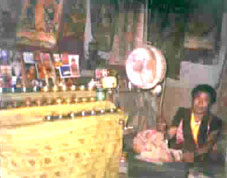
If we can strike up a practical and effective program for the second-stage
project at Tangden, it will not only work just anywhere else in the
northern region of Nepal, but also for all Himalayan communities across
national borders.
It will be this very act, therefore, of identifying and correctly
addressing the problems and needs that really exist that the mission of
the Virtual Foundation Japan's projects in Asia is all about. For, one of
the major issues confronting us at the beginning of the next century will
be the task of building a global system of cooperation at the citizens'
level which recognizes and accepts religious and cultural diversities.
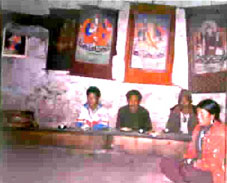
It is an undeniable fact that what has often been touted as the fusion, or
the melting pot, of the Eastern and the Western cultures has more often
turned out to be a process of forcible transplant of the West's modern
material civilization in Asia. The new Asia, as it moves into the 21st
century, should take the task upon itself of making creative contributions
to the making of a global civilization of the future by elevating Asia's
own traditions into universally acceptable values, and one way of
achieving this goal is to build Asia's own model of a modern civil
society.
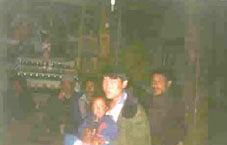
The Tangden project's total budget was USD5,000, of which 2,500 has been
collected and spent. And, we now have a chance of carefully reviewing what
has so far been accomplished, and based upon the results, we ought to
proceed with the development of the concept of the 2nd-stage project with
all these things in mind. And in this process, we ought to incorporate the
wishes and the newly felt needs of the people we have worked with.
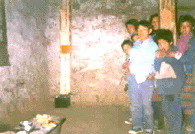
The last two pictures depict the typical profile of the people we are
talking about as they showed up at the dedication ceremony at the
monastery. Surprised and perplexed as they must have been, these young
faces nevertheless convey an air of excitement sensing the coming of a new
era at the sight of bright solar-energy light.
For us Japanese, it is as if seeing some unpublished sepia-color
photographs of the gas lights installed in Yokohama and the inauguration
of the first steam-locomotive service linking Yokohama with Tokyo in 1872.
The historical path Japan trekked during the latter half of the 19th
century and the early decades of the 20th century should not, however, be
the road to modernization for the developing countries in Asia. Japan has
the responsibility of providing Asia with the information on the darker
side of its own modernizing experience beside technological transfer and
financial assistance. Buried in Japan's own past modern history are the
important lessons how a newly emerging Asian country can possibly avoid
the course of development destructive to the natural environment on the
one hand, and stay away from the Japanese mistake of gaining the momentum
for growth at the expense of its Asian neighbors.
Following Mr. Tamura's example of launching the first Virtual Foundation
project in Asia, the students of the Chiba University of Commerce
commenced a unique project of making their Nepal project the center piece
of their seminar course under the guidance of Professor Nobuo Ota, thus
introducing a novel idea of using the Internet as an educational tool. In
addition, Dr. Takemi Ichimura of the Tokyo Life Science Laboratory has
extended his helping hand to make the project work this fall without delay
which might have jeopardized it due to climatic constraints. Thus, the
Nepal project has provided a new meeting place between students and adult
citizens interested in fostering international assistance at the citizens'
level through cyber networking. This also marks the beginning of
civil-society network in Asia for the 21st century.
A project of this scope can
be implemented with the modest budget below:
[Item 1] 2 SIESP65 Siemens 65Watt PV Module $517 x 2 units =
$1,034
[Item 2] 3 TRO24TMX Trojan Deep Cycle Battery $88 x 3
units = $264
[Item 3] 1 SYSCON30A System Controller 30 Amps $52 x 1
unit = $52
[Item 4] 14 SLDC7W CFL 7W $18 x 14 units $252
[Item 5] 1 MTFRSP75 Alum. Mounting Frame $45 x 1 unit =
$45
[Item 6] 1 INSTKIT75 Installation Materials $250 x 1 unit =
$250
Total System Cost $1,897
Transportation $200
Installation $375
Contingency $28
Grand Total $2,500
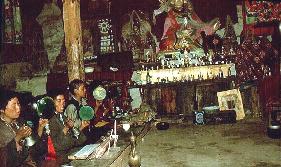
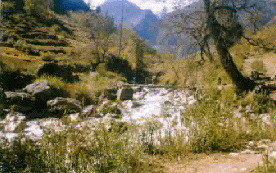
 Bordering with China to the north, and India to the southwest, in Humla,
the extreme northwestern district of Nepal, stands the Tangden Monastery
(picture to the right) above the village nestled at the foot of a mountain
slope.
Bordering with China to the north, and India to the southwest, in Humla,
the extreme northwestern district of Nepal, stands the Tangden Monastery
(picture to the right) above the village nestled at the foot of a mountain
slope.
 On this mission, however, the installation team took a helicopter ride to
the nearest landing pad, though still requiring 14 hours of trekking
through mountain paths backpacking the equipment and supplies, men and
horses alike (see the picture on the right-hand side).
On this mission, however, the installation team took a helicopter ride to
the nearest landing pad, though still requiring 14 hours of trekking
through mountain paths backpacking the equipment and supplies, men and
horses alike (see the picture on the right-hand side).
 The solar lighting project provided the Tangden monastery with a
environment-friendly lighting system. For anyone living in an urban
environment of the outside world, it will be almost impossible to imagine
how people would live without modern utilities, let alone such amenities
as telephone, radio cassettes and television. Worse than mere
inconveniences, the local people have continuously suffered from poor
eyesight and respiratory complications caused by the excessive fumes and
soot as a result of the traditional wood-burning practice for lighting
purpose inside unventilated rooms. Besides, this practice added
significantly to a steady progress of forest destruction in areas where
trees are hard to grow.
The solar lighting project provided the Tangden monastery with a
environment-friendly lighting system. For anyone living in an urban
environment of the outside world, it will be almost impossible to imagine
how people would live without modern utilities, let alone such amenities
as telephone, radio cassettes and television. Worse than mere
inconveniences, the local people have continuously suffered from poor
eyesight and respiratory complications caused by the excessive fumes and
soot as a result of the traditional wood-burning practice for lighting
purpose inside unventilated rooms. Besides, this practice added
significantly to a steady progress of forest destruction in areas where
trees are hard to grow.
 The short-term objective of this Virtual Foundation project is to provide
a safe lighting system for the monastery, which in turn is expected to
greatly enhance the environment for the religious, educational, and social
activities for the local villagers. From the long-term standpoint, it is
expected to create a living example and a show case in a remote Himalayan
district in Nepal of what solar energy can do to improve the quality of
life in many other remote areas of Asia, shedding new light on an
alternate road to modernization built upon local initiative and
technologies friendly to the natural environment.
The short-term objective of this Virtual Foundation project is to provide
a safe lighting system for the monastery, which in turn is expected to
greatly enhance the environment for the religious, educational, and social
activities for the local villagers. From the long-term standpoint, it is
expected to create a living example and a show case in a remote Himalayan
district in Nepal of what solar energy can do to improve the quality of
life in many other remote areas of Asia, shedding new light on an
alternate road to modernization built upon local initiative and
technologies friendly to the natural environment.
 The picture to the left above is a nearby village above which the Tangden
Monastery stands. People in this area earn their livelihood through hard
labor on their terraced crop lands under severe natural conditions, and it
is their voluntary contributions that the monastery is maintained as their
religious and community service center.
The picture to the left above is a nearby village above which the Tangden
Monastery stands. People in this area earn their livelihood through hard
labor on their terraced crop lands under severe natural conditions, and it
is their voluntary contributions that the monastery is maintained as their
religious and community service center.
 A functioning solar electric system such as this in a remote Buddhist
monastery in Nepal promises to enhance and expand its roles and functions
as noted above. Children can now learn more in an easier reading and
writing environment, while adult villages can also benefit from multiple
use of the existing facilities built around religious ceremonies and
events. This, in turn, will give rise to newly discovered needs in the
local life that must be addressed.
A functioning solar electric system such as this in a remote Buddhist
monastery in Nepal promises to enhance and expand its roles and functions
as noted above. Children can now learn more in an easier reading and
writing environment, while adult villages can also benefit from multiple
use of the existing facilities built around religious ceremonies and
events. This, in turn, will give rise to newly discovered needs in the
local life that must be addressed.
 The picture to the left shows the main building of the Tangden Monastery,
and workers are already on the roof installing the solar panels according
to the specifications.
The picture to the left shows the main building of the Tangden Monastery,
and workers are already on the roof installing the solar panels according
to the specifications.

 In front of the monastery and nearer to the bottom of the steep valley is
a natural cave which is used as a hidden meditation room by the monks (at
the center of the picture). Everybody helped make this project work
because of the common realization that it will not harm Tangden's pristine
nature while eliminating the health hazards the past wood-burning practice
made unavoidable. The monks and the installation workers enjoy small talks
basking in the afternoon sun near the meditation cave. It will be great if
the future Tangdens will have Internet access so that the Japanese donors
can also join them in on-line chats with those who actually do the work
and benefit from it.
In front of the monastery and nearer to the bottom of the steep valley is
a natural cave which is used as a hidden meditation room by the monks (at
the center of the picture). Everybody helped make this project work
because of the common realization that it will not harm Tangden's pristine
nature while eliminating the health hazards the past wood-burning practice
made unavoidable. The monks and the installation workers enjoy small talks
basking in the afternoon sun near the meditation cave. It will be great if
the future Tangdens will have Internet access so that the Japanese donors
can also join them in on-line chats with those who actually do the work
and benefit from it.








